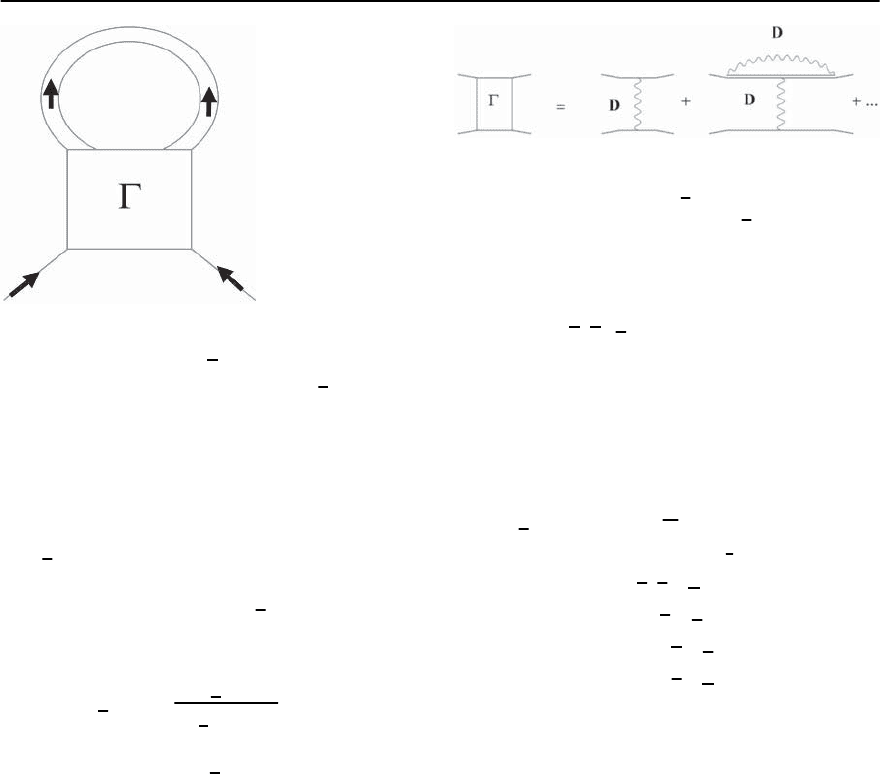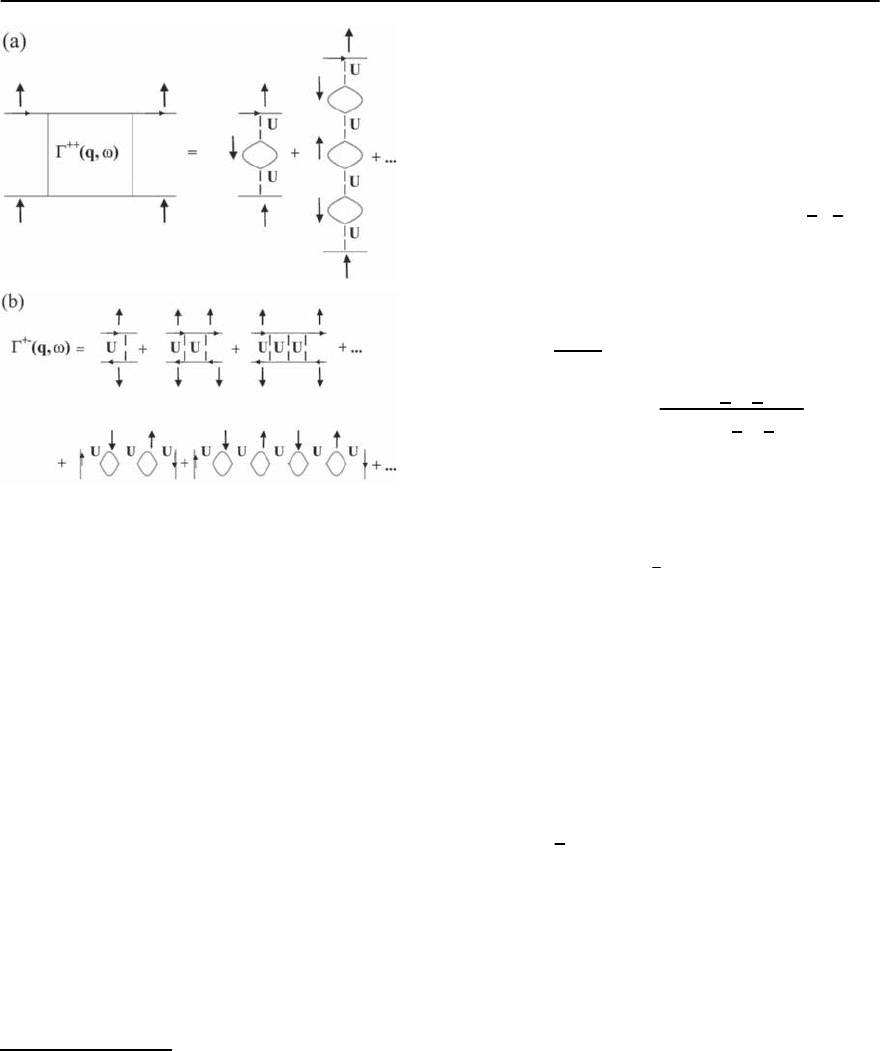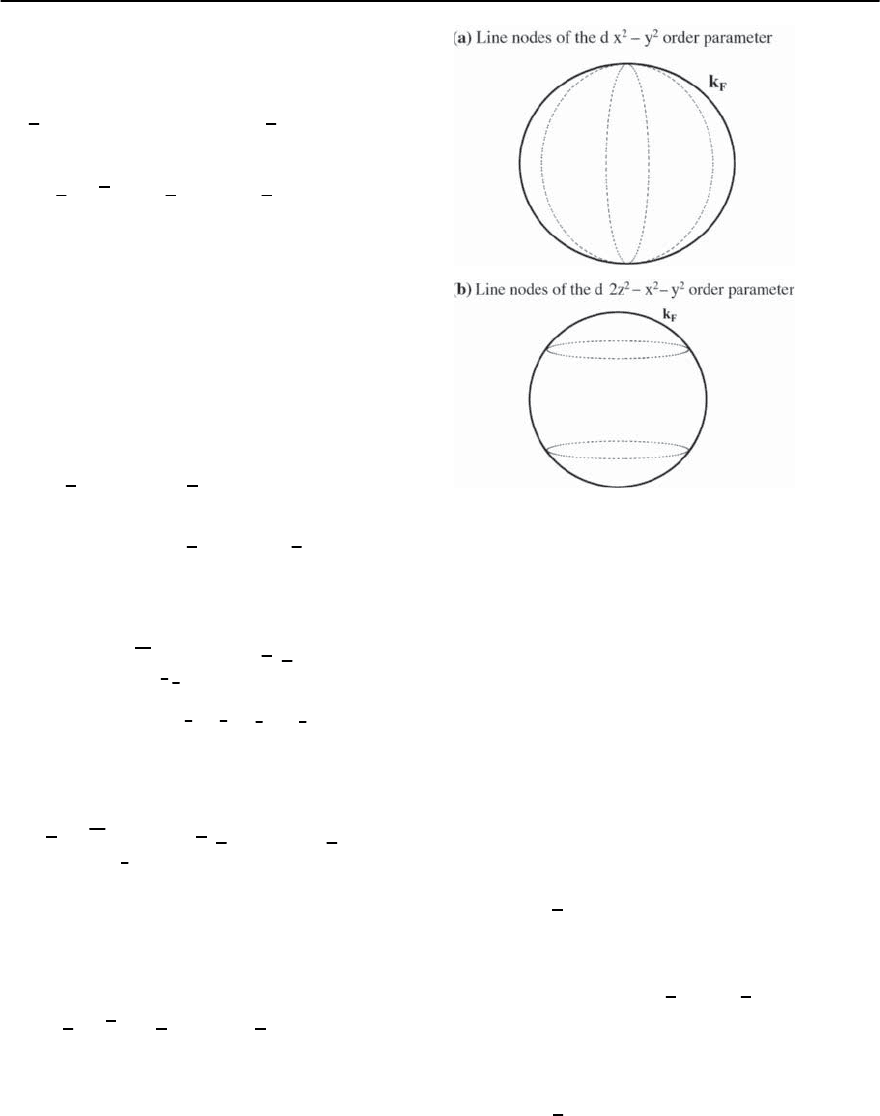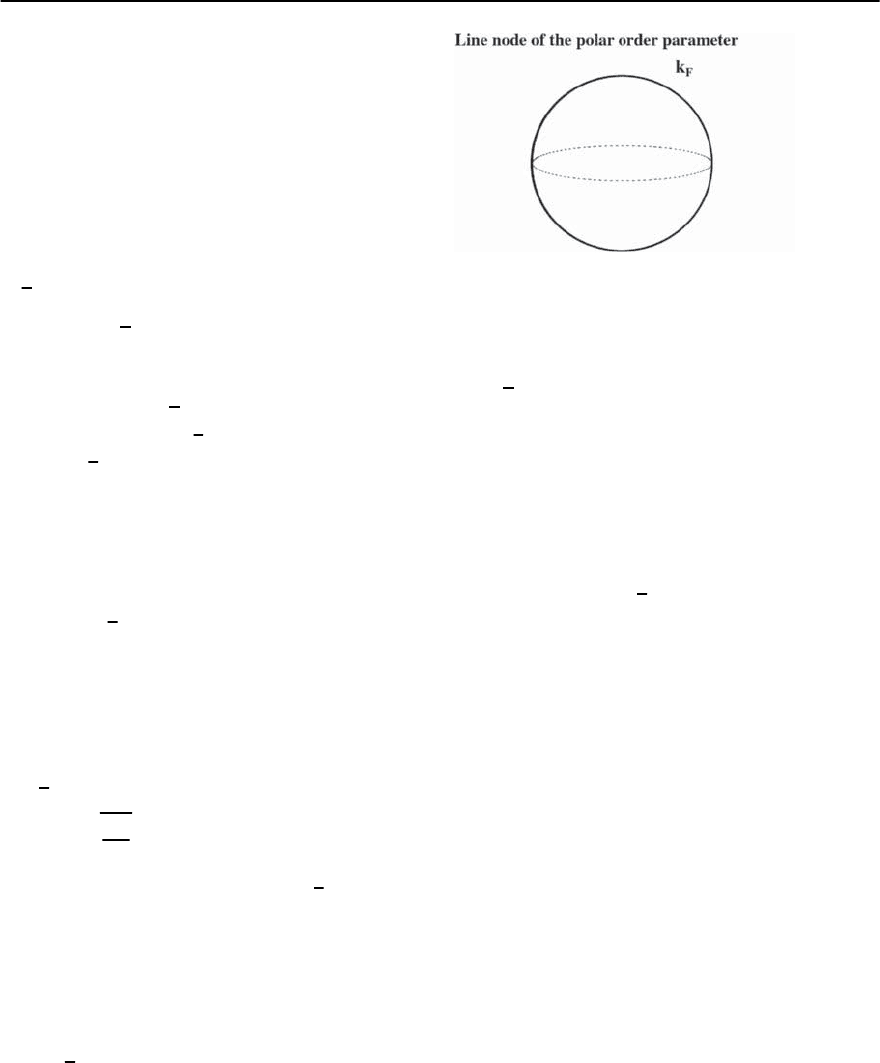Bennemann K.H., Ketterson J.B. Superconductivity: Volume 1: Conventional and Unconventional Superconductors; Volume 2: Novel Superconductors
Подождите немного. Документ загружается.


1050 P.S. Riseborough,G.M. Schmiedeshoff,and J.L.Smith
Fig. 19.17. The Feynmann diagram associated with the
anomalous self-energy £
(a)
(k; !). The solid squa re rep-
resents the irreducible vertex interaction (q
; !). The di-
rected double lines represent the fully renormalized Green’s
function
microscopic description of electron–phonon medi-
ated superconductivity lies in the Eliashberg equa-
tions [121,122] in which the superconducting gap,or
order parameter,is related to a time varying quantity
£
(a)
˛,ˇ
(k; ),which is the anomalous or pair self-energy
in the superconducting state. The gap parameter in
thequasi-particlespectra,
˛,ˇ
(k; i!
n
),isdefined in
terms of the anomalous self-energy and wave func-
tion renormalization via
(k
; !
n
)=
£
(a)
(k; i!
n
)
Z
k
(i!
n
)
. (19.30)
The self-energy £
(a)
˛,ˇ
(k; i!
n
) is depicted dia-
grammatically in Fig. 19.17. A rigorous derivation
of the Eliashberg equations for the self energies re-
lies on the validity of Migdal’s theorem [123], which
states that the vertex correction is tiny, of the order
of the square root of the ratio of the electron to the
ion mass ∼ 10
−3
. There are no analogous theorems
known for couplings to other bosonic modes such
as spin-waves [124],but nevertheless, it is still hoped
that similar equations may describe superconduct-
ing pairing mediated by other bosonic mechanisms.
In the Eliashberg equations,the gap can be expressed
in terms of the spectral density associated with the
bosonic pairing mechanism and the spectral den-
sity of the electrons forming the Cooper pairs. In the
presence of strong interactions,the spectral densities
Fig. 19.18. The Feynmann diagram expansion of the ir-
reducible vertex interaction (q
; !) in terms of bosonic
excitations. The boson propagators, D(q
; !
), are repre-
sented by the wavy lines
include appropriate self energies, and the pairing in-
teraction ismanifested through an irreducible vertex
interaction, (k
, k+q; i!
m
, i!
n
)
˛,ˇ;,
.Termscor-
responding to the irreducible vertex interaction due
to the exchange of bosons are shown in Fig. 19.18.
The self-energy, the gap, and the irreducible vertex
interaction should all be calculated self consistently.
The linearized gap equation,which determines T
c
for
the various pairings, is given by
˛,ˇ
(k; i!
n
)=−k
B
T
c
1
N
m
q
,
× (k
, k + q; i!
m
, i!
n
)
˛,ˇ;,
× G
(k + q; i!
m
)
× G
(−k − q;−i!
m
)
×
,
(k + q; i!
m
) . (19.31)
The normal state becomes unstable to the supercon-
ducting state that has the highest T
c
in the case of
no degeneracy. The criterion for a further instabil-
ity of superconducting phase to phases with other
types of pairings must be determined on the basis
of minimization of the Free energy. In the case of
strong electron–phonon coupling, the vertex correc-
tions are limited by Migdal’s theorem [123] to be
smaller than the bare vertex interaction by factors
at least as small as 10
−2
. These corrections are neg-
ligibly small and, therefore, have the effect that the
self-energies can be calculated with extremely good
accuracy. In such cases, the Eliashberg equations
have been solved. Such calculations are reviewed in
references [125, 126]. For heavy-fermion supercon-
ductors, the physics is not so clear and, despite the
absence of experimental confirmation, the validity
of a Fermi liquid picture is often assumed. Under

19 Heavy-Fermion Superconductivity 1051
this assumption, the imaginary time Green’s func-
tions in the vicinity of the Fermi energy may be re-
placed by their quasi-particle contributions.In par-
ticular, the quasi-particle masses are changed from
the band mass m
b
by the wave function renormal-
ization to Zm
b
, the quasi-particle lifetimes
0
are in-
creased to Z
0
and the strength of the quasi-particle
pole is reduced from unity by a factor Z
−1
.Theen-
hanced quasi-particle masses are simply absorbed
into a re-definition of e(k
)− as the normal state
quasi-particle energies E
k
. If the electron–phonon
coupling was proven to be the mechanism responsi-
ble for heavy-fermion superconductivity,the ratio of
the quasi-particle masses to the ionic masses are no
longer negligible so, even in this case, Migdal’s theo-
rem and the Eliashberg equations may be of doubtful
validity. Even though retardation plays an important
role in superconductivity,anapproximation that has
been frequently used consists of replacing the ver-
tex function by an appropriate interaction potential
evaluated on the Fermi surface. In this approxima-
tion, the interaction potential contains the effect of
the instantaneous Coulomb repulsion, and the lin-
earized gap equation simplifies to take the weak-
coupling BCS form [127],
˛,ˇ
(k)=Z
−2
1
N
q
,
(k, k + q)
˛,ˇ;,
×
,
(k + q) (19.32)
×
1−f (E
,k+q
)−f (E
,−k−q
)
E
,k+q
+ E
,−k−q
.
This differs from the usual BCS theory of simple su-
perconductors in that the wave function renormal-
ization Z
−1
is now explicitly included, and also,there
is an implicit difference in that the dispersion rela-
tions are those of the heavy quasi-particles. The spin
dependence of the quasi-particle energies may be
important for the occurrence of superconductivity
within a magnetically ordered phase. The summa-
tion over q
can be performed by introducing an in-
tegration over the density of states which is cut off at
afrequency,!
c
, characteristic of the bosons respon-
sible for the pairing
˛,ˇ
(
ˆ
k)=Z
−2
,
d§
4
(
ˆ
k,
ˆ
k
)
˛,ˇ;,
,
(
ˆ
k
)
×
+!
c
−!
c
dE
qp
(E)
1−2f (E)
2E
(19.33)
= Z
−1
()
,
d§
4
(
ˆ
k,
ˆ
k
)
˛,ˇ;,
×
,
(
ˆ
k
)
×
1−2f (!
c
)
ln
!
c
k
B
T
+2
!
c
k
B
T
0
dx ln x
∂
∂x
1
exp x +1
= Z
−1
()
,
d§
4
(
ˆ
k,
ˆ
k
)
˛,ˇ;,
,
(
ˆ
k
)
×
1−2f (!
c
)
ln
!
c
k
B
T
+ln
2
,
wherewehaveignoredanyspinpolarizationin
the quasi-particle bands. Usually, the Fermi func-
tion f (!
c
) is neglected under the assumption that
!
c
> k
B
T
c
, which usually holds for phonon me-
diated pairing. However, this assumption may not
be appropriate for spin-fluctuation mediated pair-
ing near a quantum critical point. In such cases, a
strong coupling approach may have to be used. In
the above expression, the electron density of states
() is un-enhanced by the interactions but is mul-
tiplied an explicit factor of Z
−1
.Aspointedoutby
Varma [128], this leads to an expression for T
c
sim-
ilar to the BCS weak-coupling form except that the
exponent is increased by a factor of Z, i.e.,
k
B
T
c
=1.14!
c
exp
−
Z
()
, (19.34)
where is the Fermi surface average of (
ˆ
k,
ˆ
k
).Thus,
the mass renormalization Z could depress T
c
.The
value of T
c
in heavy-fermion superconductorscould
also be low due to a small !
c
in the prefactor [129]
as well as in the exponent due to the appearance of
the Fermi functions.

1052 P.S. Riseborough,G.M. Schmiedeshoff,and J.L.Smith
The relationship between the nature of spin-
fluctuations and the singlet or triplet character of
the pairing is found by expanding both the on-Fermi
surface vertex function and the order parameter in
spherical harmonics. The expansions are
(
ˆ
k,
ˆ
k
)
˛,ˇ;,
=
l,m
(l)
˛,ˇ;,
Y
l
m
(
ˆ
k)
∗
Y
l
m
(
ˆ
k
)
(19.35)
and
,
(
ˆ
k)=
l,m
,
(l, m)Y
l
m
(
ˆ
k) . (19.36)
The orthogonality of the spherical harmonics Y
l
m
,
leads to an independent linearized gap equation for
each l value. Furthermore, if the spin dependence of
the vertex function is of the form
(l)
˛,ˇ;,
=(U
l
ı
˛,ˇ;,
− J
l
−→
˛;
.
−→
ˇ;
) , (19.37)
where U
l
is an effective direct Coulomb repulsion
and J
l
is an effective exchange, then, with the aid of
the identity
S (S +1)−2
3
4
ı
˛,ˇ;,
=
1
2
−→
˛;
.
−→
ˇ;
, (19.38)
where S is the total spin of the Cooper pair, one can
show that the equations for the different T
c
’s are
1=ln
k
B
T
c
!
c
Z
−1
()(U
l
+3J
l
) (19.39)
for singlet T
c
’s with S =0andevenl,while
1=ln
k
B
T
c
!
c
Z
−1
()(U
l
− J
l
) (19.40)
for triplet T
c
’s with S =1andoddl.Thenormalstate
becomes unstable to the angular momentum pairing
state with the highest T
c
. In the case where a set of
order parameters have degenerate T
c
’s,theinstability
first occurs to the state with the linear combination
of the order parameters that corresponds to the low-
est free energy [130,131]. Large values of U
0
,from
the direct Coulomb repulsion, are unfavorable for
s-wave pairing. However, U
0
represents the residual
interactions between a pair of quasi-particles and is
represented by a Fermi liquid parameter F
0
which is
unknown, a priori, and it could have a quite small
magnitude in which case s-wave pairing might still
occur. It is also seen that the q
dependence of the ef-
fective exchange interaction strongly influences the
tendency for singlet versus triplet pairing [132,133].
In analogy to the paramagnetic spin-fluctuation
pairing mechanisms [134–136] proposed for
3
He, a
number of authors [118–120] have investigated the
effect of incommensurateor antiferromagneticspin-
fluctuations within the RPA. The effective interac-
tion between a pair of electrons with parallel spins
is shown in Fig. 19.19(a). The dashed lines represent
the local Coulomb interaction, and the directed lines
represent the one-electron Green’s functions. These
diagrams only contain odd numbers of bubbles due
to the spin-dependent nature of the Coulomb repul-
sion U and are related to the longitudinal or z–z
components of the magnetic susceptibility. The re-
sulting interaction between parallel spin electrons at
the Fermi energy is given by
(k
, k
)
, : ,
=−
U
2
0
(k − k
;0)
1−U
2
2
0
(k − k
;0)
, (19.41)
where
0
(q; 0) is the static limit of the appropriate
transverse, non-interacting, reduced susceptibility,
having the usual Lindhard form.
The effective interaction between electrons with
anti-parallel spins is given by the sum of three terms,
onebeingtheonsiteCoulombrepulsionU,another
term stemming from the transverse susceptibility,
and the last term originates from the remaining part
of the longitudinal susceptibility. These terms are
depicted diagrammatically in Fig. 19.19(b) and are
evaluated as
(k
, k
)
,−;−,
= U +
U
3
2
0
(k − k
;0)
1−U
2
2
0
(k − k
;0)
+
U
2
0
(k + k
;0)
1−U
0
(k + k
;0)
. (19.42)
For values of U in the vicinity of the critical value
U
c
, the susceptibilities for q ∼ Q are enhanced
as are the effective quasi-particle interactions of
Eqs. (19.41) and (19.42). Thus, one expects the ef-
fective interaction to be highly peaked at q
values
closely connected to the Q
values of the quantum

19 Heavy-Fermion Superconductivity 1053
Fig. 19.19. The RPA expression for the irreducible inter-
action between a pair of electrons with parallel spins is
depicted in terms of Feynmann diagrams in (a). The inter-
action between electrons with anti-parallel spins is shown
in (b). The interaction not only involves the longitudinal
spin-fluctuations but also transverse spin-fluctuations
critical point.Due to the increase in the amplitude of
the spin-fluctuations as the quantum critical point is
approached, the superconducting interaction in the
paramagnetic phase is expected to be largest just
at the quantum critical point. In the magnetically
ordered phase, the transverse spin-fluctuations are
expected to transform into a branch of undamped
Goldstone modes.However,as shown by Schrieffer et
al. [137], the Goldstone modes of the antiferromag-
netically ordered state of an isotropic material do not
produce superconducting pairing. Due to the loss of
the low-energy transverse spin-fluctuation modes as
a pairing mechanism in the ordered phase and as the
amplitude (longitudinal) modes are expected to ac-
quire a mass, one expects that the superconducting
pairing will diminish deep within the magnetically
ordered phase.
3
Hence, the superconductivity is ex-
pected to occur only in close proximity to a quantum
critical point.
In comparing the relative tendencies of the nearly
ferromagnetic and nearly antiferromagnetic spin-
fluctuations in producing triplet or singlet pairings
[132, 133], it is useful to re-write the momentum
transfers for on-Fermi surface processes as |k
±k
|
2
=
2k
2
F
(1±cos ),where cos =
ˆ
k .
ˆ
k
.Then,with the use
of the addition theorem for spherical harmonics,one
finds
J
l
=
2l +1
4
0
d sin P
l
(cos ) (19.43)
×
U
2
0
(k − k
;0)
1−U
0
(k − k
;0)
,
where P
l
(x) are the Legendre polynomials. If the
system is close to a ferromagnetic instability, the
effective interaction due to the spin-fluctuations is
enhanced and positive for momentum transfers of
magnitude q =2k
F
sin
2
∼ 0, and from the prop-
erties of the Legendre function, one expects that the
strengths of J
l
are positive (P
l
(1) = 1) and decrease
with increasing l due to the increasing number of
nodes of P
l
(cos ).This, combined with a large value
of U
0
,mayforbids-wave singlet pairing and leads to
the conclusion that ferromagnetism may favor triplet
spin pairing with l = 1. That is, a ferromagnetic ex-
change between distant electrons can stabilizetriplet
pairs [138]. On the other hand, if the proximity to a
spin density wave phase enhances the susceptibility
at non-zero q
values in regions where the odd l val-
ues of P
l
(cos ) are negative ( P
l
(−1) = (−1)
l
), triplet
pairing may be unfavorable. However, even l singlet
pairing may still occur as it is stabilized by the an-
tiferromagnetic exchange. Such a simple analysis of
the strength of the various pairings is not expected
to hold in real materials with multi-sheeted Fermi
surfaces but is crucially controlled by the structure
of the Fermi surface of the normal state [76].
3
The combined effect of spin-orbit coupling and crystalline anisotropy in a heavy-fermion system may result in the
magnetic order parameter losing its continuous symmetry. Hence, the nature of the soft-modes at the transition may
change. In such cases, it might be expected that the soft-modes may remain effective in producing superconducting
pairing within the magnetically ordered phase.

1054 P.S. Riseborough,G.M. Schmiedeshoff,and J.L.Smith
The usual weak-coupling descriptionof supercon-
ducting states, developed by Bardeen Cooper and
Schrieffer [127],has a starting point that assumes the
normal state electronic system is in the Fermi liq-
uid state. The superconducting pairing interaction
is introduced, which then produces the instability
to the superconducting state. To the extent that the
pairing interactions can be treated in the mean-field
approximation, the quasi-particle concept remains
valid in the superconducting state. The absence of a
significant lifetime for the quasi-particle states es-
sentially follows from the same reasoning as in the
normal state,namely,that the Pauli-exclusion princi-
ple significantly reduces the amount of phase space
available for scattering processes. In this mean-field
description, the quasi-particle dispersion relations
E
,k
have forms that depend on the nature of the
superconducting order parameters. For the majority
of conventional superconductors, the normal state is
well described by Fermi liquid theory, and the tran-
sition to the superconducting state closely follows
the mean-field predictions. However, measurements
on some heavy-fermion systems show that the sys-
tems have not settled into the Fermi liquid phase
before the superconducting transition occurs. Thus,
the validity of the use of the quasi-particle concept
is dubious. Nevertheless, it may be expected that
some features of the heavy-fermion superconducting
states are robust in that they only depend on under-
lying symmetries and thus, would be common to the
mean-field description in terms of quasi-particles as
well as a more rigorous treatment.
19.2.5 The Symmetry of the Order Parameter
The symmetry of the superconducting order param-
eter, or more precisely the vanishing of the gap at
the Fermi energy, does lead to anomalous temper-
ature dependences of specific heat and transport
properties far below T
c
. An early series of such ex-
periments which were devised to elucidate the sym-
metry did lead to the conclusion that the supercon-
ducting gap does vanish somewhere on the Fermi
surface [5,25–31] but was equivocal on the detailed
nature of the order parameter. Nevertheless, in the
following we shall examine the possible symmetries
of the gap function and their experimental manifes-
tations. These considerations shall then be applied
to the various heavy-fermion compounds in subse-
quent sections.
TheCooperpairsarecharacterizedbythepairing
function, which is defined by the expectation value
of the productof twoelectron annihilationoperators,
a
,k
,as
¥
˛,ˇ
(k)=< |a
˛,k
a
ˇ,−k
| >, (19.44)
where ˛,andˇ denote the spin values quantized
along the z-axis. We shall consider the equilibrium
state in which the center of mass of the pairs are at
rest. For convenience we shall, as in the case of su-
perfluid
3
He [139], assume spherical symmetry and
also neglect spin-orbit scattering.Neither of these as-
sumptions arevalidfor heavy-fermion systems [140].
For f electrons, spin-orbit coupling is known to be
strong, and the anisotropy caused by the crystalline
environment also needs to be accounted for. So, both
these assumptions need to be abandoned in a proper
description of heavy-fermion superconductors. As
their abandonment only complicates the presenta-
tion [141,142]but does not invalidate the general ap-
proach being outlined, we shall make use of these as-
sumptions for pedagogical purposes. This approach
mirrors the historical development of the theoreti-
cal description of heavy-fermion superconductivity,
which often proceeded by analogy with
3
He.
The singlet pairing functionis written as the anti-
symmetrized product
¥
s
(k)=< |(a
↑,k
a
↓,−k
− a
↓,k
a
↑,−k
)| >. (19.45)
The triplet pairing functions can be expressed in
terms of the components organized by the eigenval-
ues of S
z
as
¥
t
S
z
=1
(k)=< |a
↑,k
a
↑,−k
| >,
¥
t
S
z
=0
(k)=< |(a
↑,k
a
↓,−k
+ a
↓,k
a
↑,−k
)| >.
and
¥
t
S
z
=−1
(k)=< |a
↓,k
a
↓,−k
| >. (19.46)
From consideration of the fermion anti-commu-
tation relations, one finds that the singlet pairing
function is even in k
whereas the triplet wave func-
tion is odd in k
.By considering the effects of various

19 Heavy-Fermion Superconductivity 1055
symmetries on an arbitrary pairing wave function,
one finds that in this case, one can parameterize an
arbitrary pairing functionin terms of a scalar singlet
¥
s
(k)anda(vector)triplet
−→
¥
t
(k) pairing function
via
¥
˛,ˇ
(k)=
1
2
¥
s
(k)+
−→
.
−→
¥
t
(k)
i
y
˛,ˇ
. (19.47)
The unitary operator i
y
occurs as a consequence of
the spin operator
−→
being odd under time reversal
symmetry and also as the anti-symmetric Pauli ma-
trix has the effect that
i
y
−→
(−i
y
)=−
−→
∗
. (19.48)
The direction of the triplet ordering is given in terms
of the matrix elements of the vectorpairing function
−→
¥
t
(k)=
− ¥
t
S
z
=1
(k)(ˆx + i ˆy) (19.49)
+ ¥
t
S
z
=0
(k)ˆz + ¥
t
S
z
=−1
(k)(ˆx − i ˆy)
.
If the pairing interaction is of the form
ˆ
H
int
=
1
N
k,q
˛,ˇ,,
V(k, q)
ˇ,˛: ,
× a
†
ˇ,−k
a
†
˛,k
a
,q
a
,−q
, (19.50)
then the pairing potential can be expressed as the
average
˛,ˇ
(k)=
1
N
q
,
V(k, q)
ˇ,˛: ,
¥
,
(q) . (19.51)
The above equation shows that the symmetry of the
pairing potential is related to the pairing function.By
analogy to Eq.(19.47),one can then write the pairing
potential as
˛,ˇ
(k)=
1
2
D(k
)+
−→
.
−→
d (k)
i
y
˛,ˇ
. (19.52)
The three different S
z
components of the spin triplet
pairing potential are assigned the amplitudes which
are related to the components of
−→
d
t
via
Fig. 19.20. Positionsofthelinesofnodesford-wave su-
perconductors, in momentum space. The dashed lines rep-
resent the lines of zeros of the superconducting order pa-
rameter on the spherical Fermi surface (indicated by the
solid line). (a) The lines of nodes of the d
x
2
−y
2 order pa-
rameter consists of a pair of great circles which intersect
at the poles. (b) The lines of nodes for the d
2z
2
−x
2
−y
2 phase
consists of two non-intersecting circles
−d
S
z
=1
= d
x
− id
y
,
d
S
z
=0
= d
z
, (19.53)
d
S
z
=−1
= d
x
+ id
y
.
One can expand the singlet pairing potential in the
spherical harmonics Y
l
m
(
ˆ
k)as
D(k
)=
l,m
D
l
m
(k) Y
l
m
(
ˆ
k) , (19.54)
wheredue to the symmetry imposed by fermion anti-
commutation relations D(k
)=D(−k), only even val-
ues of l contribute.Likewise, the components of the
triplet pairing potential can also be expanded in the
same way
d
S
z
(k)=
l,m
d
l
m,S
z
(k)Y
l
m
(
ˆ
k) , (19.55)

1056 P.S. Riseborough,G.M. Schmiedeshoff,and J.L.Smith
but as the pairing potential is anti-symmetric in k
d
S
z
(k)=−d
S
z
(−k), only the odd values of l con-
tribute. Thus, singlet pairing only occurs with even
values of l and triplet pairing only occurs with odd
values of l.It is noted that in anisotropic crystals, sin-
glet and triplet pairing remain mutually exclusive if
the symmetry group contains an inversion symmetry
k
→ −k.
The BCS mean-field Hamiltonian [127] can be ex-
pressed in terms of the pairing potentials as
ˆ
H
MF
=
˛,k
(e
˛
(k)−)a
†
˛,k
a
˛,k
+
˛,ˇ,k
˛,ˇ
(k)a
†
ˇ,−k
a
†
˛,k
(19.56)
+
∗
˛,ˇ
(k)a
˛,k
a
ˇ,−k
.
This apart from a constant term, can be re-expressed
as
ˆ
H
MF
=
1
2
˛,k
(e
˛
(−k)−)a
†
˛,−k
a
˛,−k
−
˛,k
( e
˛
(k)−) a
˛,k
a
†
˛,k
+
˛,ˇ,k
˛,ˇ
(k)a
†
ˇ,−k
a
†
˛,k
+
∗
˛,ˇ
(k)a
˛,k
a
ˇ,−k
. (19.57)
A four-component column operator, ¦ , is introduced
¦ (k
)=
⎛
⎜
⎜
⎜
⎝
a
↑,−k
a
↓,−k
a
†
↑,k
a
†
↓,k
⎞
⎟
⎟
⎟
⎠
,
where the first two components (and the last two)
are conjugate pairs,whereas the first and fourth (and
second and third)are time reversal partners.Thisno-
tation allows the BCS Hamiltonian to be written in
matrix form
ˆ
H
MF
=
1
2
k
¦
†
(k)
˜
H
MF
(k)¦ (k) , (19.58)
where the matrix is given by
˜
H
MF
(k) = (19.59)
⎛
⎜
⎜
⎜
⎜
⎝
e
↑
(−k)0−d
S
z
=1
(k) d
S
z
=0
(k)+D(k)
0 e
↓
(−k) d
S
z
=0
(k)−D(k) d
S
z
=−1
(k)
− d
∗
S
z
=1
(k) d
∗
S
z
=0
(k)−D
∗
(k)−e
↑
(k)0
d
∗
S
z
=0
(k)+D
∗
(k) d
∗
S
z
=−1
(k)0−e
↓
(k)
⎞
⎟
⎟
⎟
⎟
⎠
.
This mean-field Hamiltonian has quasi-particle ex-
citation energies that can be expressed as
E
,k
= (19.60)
±
(e(k)−)
2
+ |D(k)|
2
+ |
−→
d (k)|
2
− |i
−→
d (k) ∧
−→
d
∗
(k)| ,
where = ±1. Consider the term inside the square
root that is proportional to a vector product and ,
this term is real. When the vector product is zero
the pairing is said to be unitary, and when it is non-
zero the pairing is non-unitary. In the non-unitary
state, the spin degeneracy is lifted and a staggered
spin density will occur,whichis a consequence of the
spontaneous breaking of time reversal symmetry.
One important characteristic of unconventional
superconductivity is that the gap at the Fermi sur-
face may vanish for specific k
values, which are the
nodes of the order parameter. For singlet supercon-
ductivity, the gap vanishes when |D(k
)|
2
=0atthe
Fermi surface e(k
)=.
4
For triplet superconductiv-
ity, the gap vanishes when
|
−→
d (k
)|
2
±|i
−→
d (k) ∧
−→
d
∗
(k)| = 0 (19.61)
at e(k
)=. In the non-unitary state, it is possible
that the gap may vanish for only one spin direction.
The vanishing of the superconducting gap at the
nodes does produce a finite density of states for
quasi-particle excitations that may be revealed in
thermodynamic, transport, and spectroscopic mea-
surements. Although several experiments were per-
formed with the intention of establishing the exis-
tence of and characterizing the nodes, the results
were often conflicting. In retrospect, the lack of con-
sensus concerning the nature of the nodes is not sur-
prising as even Nb based superconductors show var-
ious deviationsfromstrict singlet s-waveBCSbehav-
ior.
4
The diagonal part of the self-energy has been neglected.

19 Heavy-Fermion Superconductivity 1057
For singlet s-wave superconductivity in an
isotropic system, there are no nodes. Thus, for an
isotropic singlet superconductor, the existence of
nodesisrelatedtotheformationofpairswithnon-
zero angular momenta. The singlet pairing d-wave
state, d
x
2
−y
2
, seems increasingly certain to be the
symmetry of the high temperature superconduct-
ing phase of YBa
2
Cu
3
O
7
, which has an extremely
anisotropic perovskite structure. The order param-
eter for this phase has the long wavelength form
D(k
) ∝ (k
2
x
− k
2
y
), and so the gap vanishes at lines
of nodes which form two great circles with a relative
orientation of
2
and the circles intersect at the poles
as shown in Fig. 19.20(a). Another type of d-wave
ordering is the d
2z
2
−x
2
−y
2
in which there aretwo sepa-
rate planes where D(k
)=0thatintersectwithFermi
energy in circles. As shown in Fig. 19.20(b), one cir-
cle is in the k
z
=+k
f
√
3 plane and the other in the
k
z
=−k
f
√
3plane.
There are three triplet p-wave states which have
been extensively studied in the context of
3
He. These
are all unitary states, and the first one we shall con-
sider is given by
−→
d (k
) ∝ˆxk
x
+ ˆyk
y
+ ˆzk
z
, (19.62)
which corresponds to the Balian–Werthamer (BW)
phase [143]. This pairing corresponds to one with
angular momentum
−→
J =
−→
L +
−→
S = 0, as can be seen
from re-writing the gap function as
−→
d (k
) ∝ k
sin cos ˆx +sin sin ˆy +cos ˆz
∝
7
2
3
k
ˆx − iˆy
Y
1
1
(19.63)
−
ˆx + i ˆy
Y
1
−1
+
√
2 ˆzY
1
0
,
which, on comparing with Eq. (19.49) and noting the
normalization of ¥
S
z
=0
,is easily identifiable as a state
with
−→
J = 0. The gap has a constant magnitude over
the Fermi energy, and so the gap does not vanish
for any k
values in the BW state. The BW pairing is
realized in the B phase of superfluid
3
He.
Another state is the Anderson–Brinkman–Morell
(ABM) phase [144],
Fig. 19.21. The line of nodes of the order parameter for the
polar phase of a p-wave superconductor is located on the
equatorial circle on the Fermi surface
−→
d (k
) ∝ˆz(k
x
+ ik
y
)=ˆzk sin exp[i'] , (19.64)
whichis identifiedas thestatewithS
z
=0andL
z
= .
Thus,
−→
S and
−→
L are perpendicular to each other. For
the ABM phase, the gap at the Fermi surface van-
ishesatthepointnodeswherek
x
= k
y
=0.TheABM
pairing is realized in the A phase of superfluid
3
He.
The third state is the polar phase, p
z
,where
−→
d (k
) ∝ˆzk
z
. (19.65)
This state has S
z
=0andL
z
=0.Asshownin
Fig. 19.21, the gap function vanishes at the line node
in the equatorial plane where k
z
=0.
The above singlet and triplet states may be ap-
propriate for isotropic systems but are not appro-
priate for crystals of lower symmetry. However, due
to a symmetry breaking transition, the Cooper pairs
may still have a point group symmetry lower than
the full point group symmetry of the crystalline lat-
tice. The various possible types of pairings in crys-
talline environments of different symmetries with
spin-orbit coupling have been tabulated by Ander-
son [145], Volovik and Gor’kov [142], and also by
Blount [141]. The possible pairings,neglecting spin-
orbit coupling,wereenumerated by Ozaki et al.[146].
We shall first discuss the effect of the periodic lattice
and then the effect of spin-orbit coupling.
Crystal Symmetry
The periodic symmetry of the crystalline lattice
breaks full rotational symmetry and, therefore, an-

1058 P.S. Riseborough,G.M. Schmiedeshoff,and J.L.Smith
gular momentum is no longer a good quantum num-
ber. The basis functions of the rotational group can
no longer be used to describe the pairing. However,
the basis functions appropriate to the point group
can be used. We shall focus the discussion on the O
h
group, the tetragonal group D
4h
, and the hexagonal
groupD
6h
,which are relevant to UBe
13
,CeCu
2
Si
2
and
URu
2
Si
2
,andUPt
3
. For an irreducible representation
with dimensionality d, the scalar or vector order pa-
rameter can be expressed as a linear combination of
the degenerate partner basis functions
i
(
ˆ
k) (scalar
or vector), times functions of the invariants of the
full point group,
5
f
n
(
ˆ
k). The degenerate partners are
expressed in the form
n
i,n
(
ˆ
k)f
n
(
ˆ
k). Thus, for ex-
ample, the vector order parameter is expressed as
−→
d (
ˆ
k)=
i=d
i=1
C
i
n
−→
i,n
(
ˆ
k) f
n
(
ˆ
k)
(19.66)
and an analogous equation holds true for the sin-
glet order parameter D(k
). The summation over n
runs through d and 3d values respectively,for singlet
and triple pairings [147]. A specific example found
in Table(19.2) for singlet pairing in cubic symme-
try is the doubly degenerate
+
3
(E
g
) representation in
which the degenerate partners basis functions have
the form
1
(
ˆ
k)=
n=2;4
(k
n
x
+ k
n
y
−2k
n
z
)f
n
(
ˆ
k) ,
2
(
ˆ
k)=
n=2;4
(k
n
x
− k
n
y
) , f
n
(
ˆ
k) (19.67)
where the f
n
(
ˆ
k)havetheforma
n
+ b
n
k
2
+ c
n
(k
4
x
+
k
4
y
+ k
4
z
)+.... Likewise, for cubic symmetry, the
singly-degenerate triplet pairing
−
1
(A
1u
)represen-
tation found in Table 19.3 has the basis function
−→
1
(
ˆ
k)=
n=1;3;5
(ˆxk
n
x
+ ˆyk
n
y
+ ˆzk
n
z
)f
n
(
ˆ
k) . (19.68)
The coefficients C
i
multiplying the degenerate part-
ner basis functions are arbitrary and are determined
only by the spontaneous symmetry broken state. The
Table 19.2. Singlet pairing basis functions for the cubic
group O
h
. The forms of the degenerate partners are shown.
As explained in the text, the components labelled by n must
be multiplied by an invariant function f
n
(k) and summed
over n to yield a degenerate partner. The degenerate part-
ners are separated by commas
Representation Basis Functions
+
1
(A
1g
)1
+
2
(A
2g
)(k
2
x
− k
2
y
)(k
2
y
− k
2
z
)(k
2
z
− k
2
x
)
+
3
(E
g
)2k
n
z
− k
n
x
− k
n
y
, k
n
x
− k
n
y
n=2; 4
+
4
(T
1g
) k
x
k
y
(k
n
x
− k
n
y
) , k
y
k
z
(k
n
y
− k
n
z
) , k
z
k
x
(k
n
z
− k
n
x
)
n=2; 4; 6
+
5
(T
2g
) k
x
k
y
k
n
z
, k
y
k
z
k
n
x
, k
z
k
x
k
n
y
n=0; 2; 4
invariant functions f
n
(
ˆ
k) corresponding to the ad-
mixtures of the different angular momentum com-
ponents are well defined for each representation
and should be determined by minimization of the
free energy. The tetragonal symmetry singlet and
triplet representation basis functions are given in
Tables 19.4 and 19.5, respectively. The basis for the
non-degenerate singlet pairings in the tetragonal
+
3
(B
1g
) representation is written, with different no-
tation k
±
= k
x
± ik
y
,as
1
(
ˆ
k)=(k
2
x
− k
2
y
)f (
ˆ
k)=Rek
2
+
f (
ˆ
k) , (19.69)
where the expansion of the invariant function no
longer has a quadratic term in the modulus of k
but
instead,has the different form f (
ˆ
k)=a+bk
2
z
+c(k
2
x
+
k
2
y
)+.... The triplet pairing in a D
4h
structure be-
longing to the representation
−
1
(A
1u
)hastheform
given by,
−→
1
(
ˆ
k)=ˆzk
z
f
0
(
ˆ
k)+
n=1;3
(ˆxk
n
x
+ ˆyk
n
y
)f
n
(
ˆ
k) . (19.70)
Even though the crystal field mixes states of dif-
ferent angular momentum, one can usually identify
the pairing states via the dominant components of
the orbital angular momentum. For example, in the
cubic group with spin singlet pairing shown in Ta-
ble 19.2, we identify the nodeless one-dimensional
5
It is possible that the functions f
n
(
ˆ
k)vanishatsomek points,thereby producing nodes in the order parameter.However,
the set of nodes that are produced in this way will still have the full point group symmetry of the lattice.

19 Heavy-Fermion Superconductivity 1059
Table19.3. Triplet pairing basis functions in the cubic O
h
group.Thevectork is just the radial vector given by ˆxk
x
+ ˆyk
y
+ˆzk
z
.
The components of the symmetric partners are separated by colons, whereas the symmetric partners are separated by
commas
Representation Basis Functions
−
1
(A
1u
) ˆxk
n
x
+ ˆyk
n
y
+ ˆzk
n
z
n=1;3;5
−
2
(A
2u
) ˆxk
n
x
(k
2
y
− k
2
z
)+ˆyk
n
y
(k
2
z
− k
2
x
)+ˆzk
n
z
(k
2
x
− k
2
y
)
n=1; 3; 5
−
3
(E
u
) ˆxk
n
x
− ˆyk
n
y
, ˆxk
n
x
+ ˆyk
n
y
−2ˆzk
n
z
n=1; 3; 5
(k
n
x
− k
n
y
)k ,(2k
n
z
− k
n
x
− k
n
y
)k
n=2; 4
ˆxk
5
x
k
2
z
− ˆyk
5
y
k
2
z
+ ˆzk
5
z
(k
2
x
− k
2
y
),
ˆxk
5
x
(k
2
z
−2k
2
y
)+ˆyk
5
y
(k
2
z
−2k
2
x
)+ˆzk
5
z
(k
2
x
+ k
2
y
)
−
4
(T
1u
) k
m
x
(ˆyk
n
z
− ˆzk
n
y
),k
m
y
(ˆzk
n
x
− ˆxk
n
z
),k
m
z
(ˆxk
n
y
− ˆyk
n
x
);
n=1;3;5 m=0;2
ˆxk
y
k
z
(k
2
y
− k
2
z
)k
n
x
, ˆyk
z
k
x
(k
2
z
− k
2
x
)k
n
y
, ˆzk
x
k
y
(k
2
x
− k
2
y
)k
n
z
;
n=1; 3; 5
−
5
(T
2u
) k
m
z
(ˆyk
n
x
+ ˆxk
n
y
),k
m
x
(ˆzk
n
y
+ ˆyk
n
z
),k
m
y
(ˆxk
n
z
+ ˆzk
n
x
);
n=1; 3; 5 m=0; 2
ˆzk
x
k
y
k
n
z
, ˆxk
y
k
z
k
n
x
, ˆyk
x
k
z
k
n
y
;
n=1;3;5
+
1
(A
1g
)representationwiths-wave pairing and the
lowest components of the
+
3
(E
g
)(n =2)and
+
5
(T
2g
)
(n = 0) representations as the crystal field split mem-
bers of the five-dimensional d-wave pairing basis.
Likewise,fortriplet pairing in the cubicgroup shown
in Table 19.3, we can identify the one-dimensional
basis (formed by selecting the n =1component)of
−
1
(A
1u
) and the two-dimensional basis (also formed
by selecting n =1)of
−
3
(E
u
)asthecrystalfield
split three-dimensional p-wave pairing basis func-
tions.Thenodestructureforthenon-degeneraterep-
resentations can be found. For example, in a cubic
structure with singlet pairing, the high symmetry
reduces the number of non-degenerate representa-
tions to two. These are the
+
1
(A
1g
) phase, which is
nodeless and the
+
2
(A
2g
) phase, where the order pa-
rameter vanishes on six distinct planes.
In the
+
2
(A
2g
) phase, the six planes intersect the
three-dimensional Fermi surface on six distinct arcs,
giving six lines of nodes on the Fermi surface. In a
structure with lower symmetry such as the tetrago-
nal structure, the number of non-degenerate singlet
representations is four.The possible singlet phases in
D
4h
are shown in Table 19.4. In addition to the node-
less
+
1
(A
1g
) phase,one finds the two non degenerate
+
3
(B
1g
),and
+
4
(B
2g
) phases,which each produce two
lines of nodes as expected for d-wave pairing, and
finally the order parameter for the
+
2
(A
2g
)pairing
vanishes on four planes giving four lines of nodes.
For tripletpairing,the occurrenceof nodesis gen-
erally rarer than for singlet pairings since the three
components of
−→
d (k) must vanish simultaneously.
The need to satisfy three conditions may be expected
to reduce the dimensions of the nodes from a sur-
face to a set of isolated points, which need not lie
on the Fermi surface. Inspection of Table 19.3 shows
that this is the case for the O
h
−
1
(A
1u
) phase where
the components vanish on orthogonal planes pro-
ducing isolated zeros not on the Fermi surface, so
the gap has no nodes. The components of the order
parameter for the highly symmetric non-degenerate
−
2
(A
2u
) phase each vanishon threeplanes.This leads
